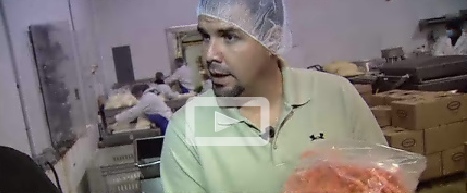On Aug. 17, 2008, the Canadian Food Inspection Agency (CFIA) and Maple Leaf Foods, Inc. finally got around to telling Canadians they should avoid serving or consuming certain brands of deli meat as the products could be contaminated with L. monocytogenes. In the end, 23  deaths and 57 cases of listeriosis were linked to contaminated cold-cuts made by Maple Leaf.
deaths and 57 cases of listeriosis were linked to contaminated cold-cuts made by Maple Leaf.
In July 2009, investigator Sheila Weatherill who was appointed directly by the Canadian Prime Minister, issued a 181-page final report about the listeria crapfest, with 57 recommendations grouped into four broad categories:
– more focus on food safety among senior officials in both the public and private sectors;
– better preparedness for dealing with a serious foodborne illness with more advance planning for an emergency response;
– a greater sense of urgency if another foodborne emergency occurs; and,
– clearer communications with the Canadian public about listeriosis and
other foodborne illnesses, especially at risk populations and health professionals.
zzzzzzzzzzzzzzzzzzzzzz
On Oct. 21, 2010, CFIA issued a couple of public reports, responding to the Weatherill report, all this over two-years after people starting barfing and dying from Maple Leaf meats. Buried within the bureaucratese are a few nuggets that show Canadian food safety types are trying to say the right thing – but really don’t get it.
Most of the media coverage focused on meat inspection protocols and complaints by the union of too few inspectors. There’s this big debate about who needs to do what and whether the federally-mandated Compliance Verification System (CVS), which sets out the procedures to be used by inspectors to verify the design and implementation of a plant’s food safety plan, is any good.
However, within the Oct. 2010 food safety progress report, the feds are apparently trying to come up with guidance on when to go public about food safety risks.
“Health Canada is developing a federal guidance document on the weight of evidence needed to take action to protect consumers during foodborne illness outbreak investigations. The weight of evidence takes into consideration the microbiological information gathered through food sample testing and human illness reports, as well as the information collected from the follow-up investigation at food processing plants. Federal, provincial and territorial partners have been consulted on the (1)(1).jpg) draft guidance document. Health Canada also shared the document with selected international counterparts in June 2010. Once finalized, the document will be used by Health Canada, CFIA and PHAC during outbreak investigations.”
draft guidance document. Health Canada also shared the document with selected international counterparts in June 2010. Once finalized, the document will be used by Health Canada, CFIA and PHAC during outbreak investigations.”
I look forward to the public availability of such a document, 14 years after the feds were criticized for the erroneous implication of California strawberries rather than Guatemalan raspberries as the source of a 1996 North America-wide cyclospora outbreak.
The Weatherill Report makes a number of recommendations to improve communication between government and the public on food safety and foodborne illness. The Government has taken steps to improve how and when it communicates with Canadians in general and with at-risk populations and key stakeholders, specifically. These steps take into consideration how it communicates food safety information in periods when there is no outbreak as well as during a national foodborne illness event.
In February 2010, the Government of Canada launched an online Food Safety Portal that offers a one-stop source for information about food safety and foodborne illness (www.foodsafety.gc.ca). The food safety and foodborne illness information initiatives developed by CFIA, PHAC and Health Canada and described in this report can now be found on the Portal.
To raise awareness of the Food Safety Portal, CFIA sent out a social media news release that encourages individuals to share information about the Portal online by using social media book-marking and tagging options, thus ensuring the broadest possible outreach.
CFIA has also been using social media tools, such as Twitter, to reach a wider audience on food safety issues and recalls. The Agency has gained over 400 followers on Twitter, including representatives from the media, health organizations, consumer groups and cooking/food allergy bloggers. In addition, CFIA has developed a recall widget to automate further distribution of notices. Food safety stakeholders have been invited to embed the CFIA widget on their websites, blogs, or social media pages to display live content from CFIA on food recalls.
The Consumer Centre section of the CFIA website has also been redesigned to clearly explain the roles that consumers, government and industry play in food safety, and to provide more information on important food safety issues. In addition, CFIA is participating in six .jpg) food-related events between May 2010 and March 2011 to promote the Food Safety Portal and raise awareness of safe food handling practices and recall procedures.
food-related events between May 2010 and March 2011 to promote the Food Safety Portal and raise awareness of safe food handling practices and recall procedures.
And it goes on and on.
Creating a new web site doesn’t mean anyone reads it. And using social media is of no use if the messages still suck. People dying from deli meat is not a food handling concern.
PHAC has developed a risk communications strategy that will guide how the Agency communicates to Canadians during a national foodborne illness outbreak. PHAC has begun to implement various components of the strategy so that it can communicate to the public, key stakeholders, and targeted at-risk populations (older adults, pregnant women and those with weakened immune systems) more effectively. The strategy uses a variety of traditional and innovative formats, such as media events, web- and audio-casts, the Food Safety Portal, and stakeholder briefings. PHAC also collaborates with Health Canada to ensure that PHAC’s information for Canadians during a national outbreak is consistent with the food safety information that Health Canada provides.
There’s more but it’s tortuous. No evaluation of effectiveness, no indication that fewer people are barfing, no evidence that dieticians at care facilities won’t keep giving out cold deli meats to at-risk populations, no evidence that medical types at place like the Toronto Hospital for Sick Kids won’t keep dispensening stupid advice about listeria risks to pregnant women.
And for all the bureaucratese, no mention was made by anybody about Weatherill’s recommendation for precautionary labeling – warning labels – for listeria-vulnerable populations like pregnant women and old folks.
There must have been hundreds of fully salaried government types at all the meetings and in the report prep and website building and travel.
Maple Leaf or any other processor, government can continue to dither, you’re the ones losing customers and profits.
Make listeria testing results publicly available, and put warning labels or some sort of information available on the package. And stop saying deli meat is a consumer handling problem.
Waiting for government is like waiting for Godot.
.jpg) daughter would pay her respects at Ms Carter’s funeral.
daughter would pay her respects at Ms Carter’s funeral.
 sentenced to eight months in prison by Mold Crown Court.
sentenced to eight months in prison by Mold Crown Court..jpg) poisoning bug. He was one of 158 victims, most of them children, struck down by the O157 strain.
poisoning bug. He was one of 158 victims, most of them children, struck down by the O157 strain. that we are not going to get the outcome that Mason deserves. I’m just hoping that I find the strength from somewhere to get through the next couple of days. I have experienced the worst thing I can ever experience, but having to deal with the inquest comes second. The hurt never goes away when you lose a child. You never get over it – you learn to live alongside it.”
that we are not going to get the outcome that Mason deserves. I’m just hoping that I find the strength from somewhere to get through the next couple of days. I have experienced the worst thing I can ever experience, but having to deal with the inquest comes second. The hurt never goes away when you lose a child. You never get over it – you learn to live alongside it.” same products. This independent testing shows our produce to be absolutely safe, and we are aggressively fighting the state’s erroneous findings.”
same products. This independent testing shows our produce to be absolutely safe, and we are aggressively fighting the state’s erroneous findings.” deaths and 57 cases of listeriosis were linked to contaminated cold-cuts made by Maple Leaf.
deaths and 57 cases of listeriosis were linked to contaminated cold-cuts made by Maple Leaf.(1)(1).jpg) draft guidance document. Health Canada also shared the document with selected international counterparts in June 2010. Once finalized, the document will be used by Health Canada, CFIA and PHAC during outbreak investigations.”
draft guidance document. Health Canada also shared the document with selected international counterparts in June 2010. Once finalized, the document will be used by Health Canada, CFIA and PHAC during outbreak investigations.”.jpg) food-related events between May 2010 and March 2011 to promote the Food Safety Portal and raise awareness of safe food handling practices and recall procedures.
food-related events between May 2010 and March 2011 to promote the Food Safety Portal and raise awareness of safe food handling practices and recall procedures. they thought at first it was just a run-of-the-mill stomach upset and waited for it to run its course.
they thought at first it was just a run-of-the-mill stomach upset and waited for it to run its course.